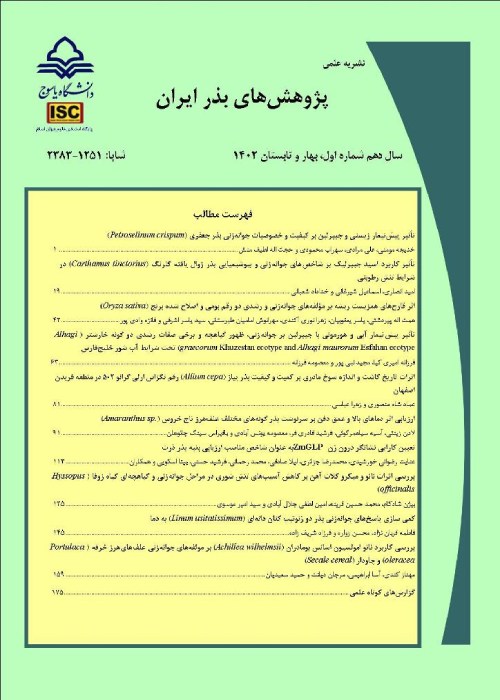Comparison of Salinity Tolerance in Non-Iranian Primary Tritipyrum Promising Lines with Two Wheat Cultivars in Germination Stage
Salinity stress is one of the most important factors in decreasing crop yield. Crossing between cultivars and wild relatives is one of the methods to creating salinity tolerant plants that has led to the creation of new Tritipyrum cereals. Investigation of the effect of salinity stress at the germination stage is a reliable test in assessing salinity tolerance of many species; it reduces percentage and rate germination as well as decreases of root and shoots growth. This research aims to investigate the effects of different levels of salinity stress on germination of promising non-Iranian Tritipyrum lines and two wheat cultivars, Alvand (salinity tolerant) and Ghods (salinity sensitive).
The experiment was conducted in factorial based on the completely randomized design at the Faculty of Agriculture, Yasouj University. The first factor consisted of 13 Tritipyrum lines and two wheat cultivars and the second factor consisted of different salinity levels (240, 160, 80, 0 mM NaCl). After surface disinfection and seed culture in a petri dish, germination-related traits were measured until the 14th day.
The results showed that by increasing salinity level, germination rate and percentage, root length, shoot length, dry and fresh root weight, and shoot dry weight decreased. The highest percentage (79.79%) and rate (75.74 seed per day) of germination in stress and non-stress conditions were related to the Az/b line. The germination percentage of the Alvand tolerant cultivar (55.59%) was higher than 5 Tritipyrum lines but less than the other 7 lines, its germination rate (53.69 seed per day) was higher than 10 Tritipyrum lines. The percentage and germination rate of sensitive cultivar Ghods (40.98 and 36.87 seed per day, respectively) were lower than all Tritipyrum lines. Under salinity stress, the La/b line had the highest root length (7.77 cm) which was even longer than the root length of the Alvand tolerant cultivar (4.9 cm). The highest root dry weight (0.027 g) under stress conditions was related to the Ka/b line and the lowest root dry weight (0.013 cm) was related to the Ghods cultivar. Among germination traits, the highest and the lowest heritability were related to shoot length under stress and non-stress conditions and root fresh weight (under non-stress conditions) and root length (under stress conditions), respectively. Genetic variance of shoot length and germination percentage in non-stress conditions was higher than stress conditions and selection under non-stress conditions had a higher yield than stress conditions. Clustering of genotypes by cluster analysis divided the genotypes into four groups under normal and salinity conditions. Under salinity stress, the salt-tolerant cultivar was placed alone in the fourth cluster. The salinity-sensitive cultivar was also in the third cluster with the St/b line. The rest of the Tritipyrum lines were clustered in the first and second clusters, with (Ka/b)(Cr/b)F6 hybrid line in the first cluster. Salt stress condition seems to have separated Qods from all Tritipyrum lines (except St/b), but under normal conditions, it did not indicate clustering accuracy of the studied genotypes.
The results of this study demonstrated salinity tolerance in the most simple and hybrid lines of this plant at the germination stage, among them (St/b)(Cr/b)F3, (Ka/b)(Cr/b)F6, and (Ka/b)(Cr/b)F3 and La(4B/4D)×(b) and the simple lines La/b, Az/b and St/b were better than others. Therefore, these selected lines can be considered in further complementary studies.
- حق عضویت دریافتی صرف حمایت از نشریات عضو و نگهداری، تکمیل و توسعه مگیران میشود.
- پرداخت حق اشتراک و دانلود مقالات اجازه بازنشر آن در سایر رسانههای چاپی و دیجیتال را به کاربر نمیدهد.




